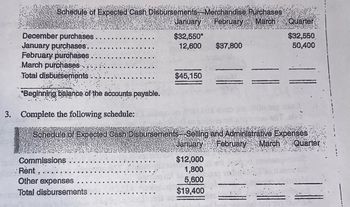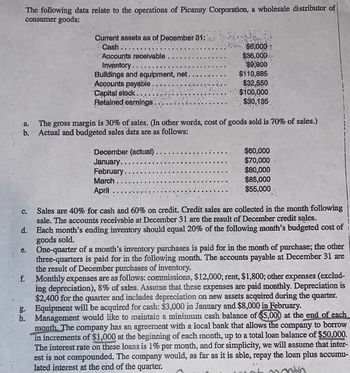
FINANCIAL ACCOUNTING
10th Edition
ISBN: 9781259964947
Author: Libby
Publisher: MCG
expand_more
expand_more
format_list_bulleted
Question
thumb_up100%
Solve these two problems with data given - please provide instructions on answers

Transcribed Image Text:Schedule of Expected Cash Disbursements Merchandise Purchases
January February March Quarter
December purchases..
January purchases.
February purchases.
March purchases.
Total disbursements.
*Beginning balance of the accounts.payable.
$32,550*
12,600 $37,800
Commissions
Rent.
Other expenses
Total disbursements
$45,150
3. Complete the following schedule:
Schedule of Expected Cash Disbursements Selling and Administrative Expenses
February March Quarter
January
$32,550
50,400
$12,000
1,800
5,600
$19,400

Transcribed Image Text:The following data relate to the operations of Picanuy Corporation, a wholesale distributor of
consumer goods:
a.
b.
C.
d.
e.
f.
g.
h.
Current assets as of December 31:
Cash.
Accounts receivable
Inventory..
Buildings and equipment, net.
Accounts payable
Capital stock..
Retained earnings.
$6,000
$36,000
$9,800
$110,885
$32,550.
$100,000.
$30,135
The gross margin is 30% of sales. (In other words, cost of goods sold is 70% of sales.)
Actual and budgeted sales data are as follows:
December (actual).
January.
February..
March..
April
$60,000
$70,000
$80,000
$85,000
$55,000.
Sales are 40% for cash and 60% on credit. Credit sales are collected in the month following
sale. The accounts receivable at December 31 are the result of December credit sales.
Each month's ending inventory should equal 20% of the following month's budgeted cost of
goods sold.
One-quarter of a month's inventory purchases is paid for in the month of purchase; the other
three-quarters is paid for in the following month. The accounts payable at December 31 are
the result of December purchases of inventory.
Monthly expenses are as follows: commissions, $12,000; rent, $1,800; other expenses (exclud-
ing depreciation), 8% of sales. Assume that these expenses are paid monthly. Depreciation is
$2,400 for the quarter and includes depreciation on new assets acquired during the quarter.
Equipment will be acquired for cash: $3,000 in January and $8,000 in February.
Management would like to maintain a minimum cash balance of $5,000 at the end of each
month. The company has an agreement with a local bank that allows the company to borrow
in increments of $1,000 at the beginning of each month, up to a total loan balance of $50,000.
The interest rate on these loans is 1% per month, and for simplicity, we will assume that inter-
est is not compounded. The company would, as far as it is able, repay the loan plus accumu-
lated interest at the end of the quarter.
moth
Expert Solution
This question has been solved!
Explore an expertly crafted, step-by-step solution for a thorough understanding of key concepts.
Step by stepSolved in 3 steps

Follow-up Questions
Read through expert solutions to related follow-up questions below.
Follow-up Question
why did you multiple required purchases by 1/4 & 3/4? I am confused on this as i dont see it in the instructions.
Solution
by Bartleby Expert
Follow-up Questions
Read through expert solutions to related follow-up questions below.
Follow-up Question
why did you multiple required purchases by 1/4 & 3/4? I am confused on this as i dont see it in the instructions.
Solution
by Bartleby Expert
Knowledge Booster
Learn more about
Need a deep-dive on the concept behind this application? Look no further. Learn more about this topic, accounting and related others by exploring similar questions and additional content below.Similar questions
Recommended textbooks for you

 AccountingAccountingISBN:9781337272094Author:WARREN, Carl S., Reeve, James M., Duchac, Jonathan E.Publisher:Cengage Learning,
AccountingAccountingISBN:9781337272094Author:WARREN, Carl S., Reeve, James M., Duchac, Jonathan E.Publisher:Cengage Learning, Accounting Information SystemsAccountingISBN:9781337619202Author:Hall, James A.Publisher:Cengage Learning,
Accounting Information SystemsAccountingISBN:9781337619202Author:Hall, James A.Publisher:Cengage Learning, Horngren's Cost Accounting: A Managerial Emphasis...AccountingISBN:9780134475585Author:Srikant M. Datar, Madhav V. RajanPublisher:PEARSON
Horngren's Cost Accounting: A Managerial Emphasis...AccountingISBN:9780134475585Author:Srikant M. Datar, Madhav V. RajanPublisher:PEARSON Intermediate AccountingAccountingISBN:9781259722660Author:J. David Spiceland, Mark W. Nelson, Wayne M ThomasPublisher:McGraw-Hill Education
Intermediate AccountingAccountingISBN:9781259722660Author:J. David Spiceland, Mark W. Nelson, Wayne M ThomasPublisher:McGraw-Hill Education Financial and Managerial AccountingAccountingISBN:9781259726705Author:John J Wild, Ken W. Shaw, Barbara Chiappetta Fundamental Accounting PrinciplesPublisher:McGraw-Hill Education
Financial and Managerial AccountingAccountingISBN:9781259726705Author:John J Wild, Ken W. Shaw, Barbara Chiappetta Fundamental Accounting PrinciplesPublisher:McGraw-Hill Education


Accounting
Accounting
ISBN:9781337272094
Author:WARREN, Carl S., Reeve, James M., Duchac, Jonathan E.
Publisher:Cengage Learning,

Accounting Information Systems
Accounting
ISBN:9781337619202
Author:Hall, James A.
Publisher:Cengage Learning,

Horngren's Cost Accounting: A Managerial Emphasis...
Accounting
ISBN:9780134475585
Author:Srikant M. Datar, Madhav V. Rajan
Publisher:PEARSON

Intermediate Accounting
Accounting
ISBN:9781259722660
Author:J. David Spiceland, Mark W. Nelson, Wayne M Thomas
Publisher:McGraw-Hill Education

Financial and Managerial Accounting
Accounting
ISBN:9781259726705
Author:John J Wild, Ken W. Shaw, Barbara Chiappetta Fundamental Accounting Principles
Publisher:McGraw-Hill Education